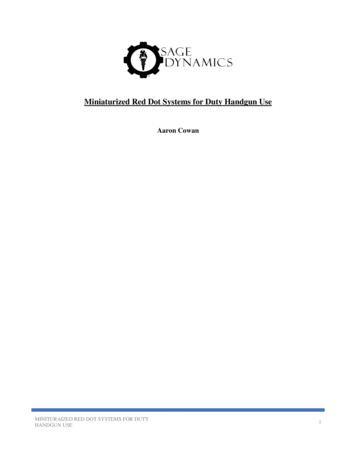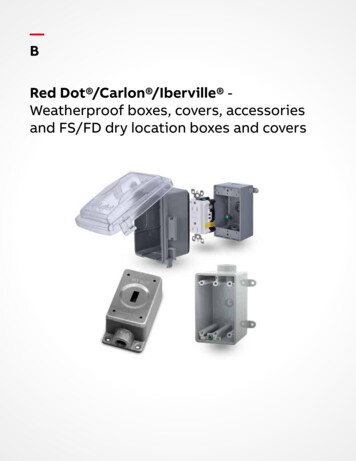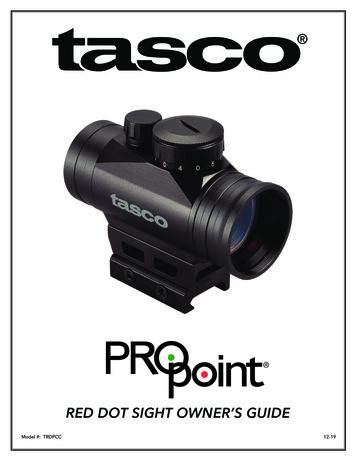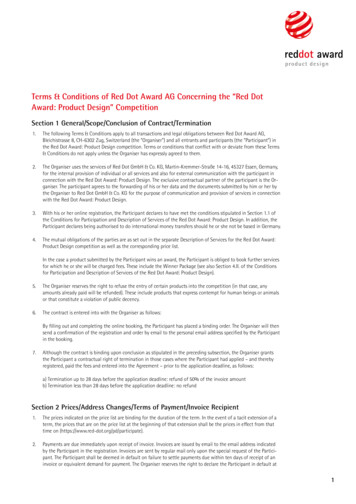
Transcription
Miniaturized Red Dot Systems for Duty Handgun UseAaron CowanMINITURAIZED RED DOT SYSTEMS FOR DUTYHANDGUN USE1
Table of tion and Features66Equipment ImplementationExternal MountsMilled SlideOEM Milled SlidesAdditional OptionsDuty HolstersOptic Care991011121214Optic DurabilityEvaluated MRDS1515Visual and Mental Complications During a Use of ForceHuman Vision Under StressMental Processing Under StressSights in Reduced LightingConstant Threat FocusLiability Under Traditional Training Methods181826273032Advantages of Red Dot OpticsOne Focal PlaneAccuracy Improvement With the MRDSMRDS Use in Force on Force34343540MRDS Adaptation and TrainingSelecting an MRDS ModelFundamental Level InstructionAddressing Optic Failure in TrainingConclusion5454555963MINITURAIZED RED DOT SYSTEMS FOR DUTYHANDGUN USE2
ForewordThis document marks the culmination over 4 years of research, testing, field use and evaluation ofminiaturized red dot sight (MRDS) for duty purposes. The original hypothesis was; that a MRDS is notonly more efficient than traditional iron sights for the duty handgun, but that the MRDS would providedistinct advantages not possible with proper iron sight use.Specifically, MRDS would allow a shorter learning period to proper accuracy for mandated firearmstraining and qualification, and allow officers to maintain proficiency easier due to the less complexoptical methods used to properly aim with the MRDS.Additionally, the MRDS allows the officer to maintain a constant focus on the target, which cansignificantly improve threat awareness, help mitigate mistake of fact shootings and aid in more preciseround placement over traditional iron sights.This document is available publicly and may be used for justification, policy and/or research purposes,so long as it is cited in its entirety without modification or editing and credit is given to the originalauthor.Cited documents are property of their respective authors and sources.MINITURAIZED RED DOT SYSTEMS FOR DUTYHANDGUN USE3
IntentThe critical nature of accuracy is a well-studied and often criticized aspect of law enforcement. Thegeneral standards for officer accuracy have traditionally been driven by policy, mandated qualificationsthat provide official records of an individual’s ability to meet an administrative standard.This administrative standard, while important, only speaks to a criterion for record and may notaccurately measure an officer’s accurate skill during a use of force situation.The core purpose of an officer’s accuracy is to defend life. Society has trusted our officers with theability to use force and they are expected to be good at it. It falls on a department to give their trainingcadre, range instructors and individual officers all the tools they need to meet and exceed this trust.To meet this mandate, departments must be prepared to embrace new technology, properly vetted, andevaluate its necessity for their officers. If a new methodology or technology can improve officereffectiveness and aid in reducing mistake-of-fact use of force, then it is imperative that it be madeavailable to officers.This document was created to give administrators, range masters and officers the information they needto make an informed decision on the testing and implementation of MRDS equipped duty handguns.MINITURAIZED RED DOT SYSTEMS FOR DUTYHANDGUN USE4
SummaryThis document lays out the understanding and advantages for adoption of miniaturized red dot optics forlaw enforcement duty handguns. Establishing that human psychophysiology is not best served withtraditional iron sight method of aiming, the red dot is a superior method of aiming due to the correctnature of use in which the officer can remain threat focused instead of having to complete multiple focalpoint changes before force can be used.Furthermore, the adoption of red dot optics can go far to preventing mistake of fact shootings under thesame advantage; the officer maintains a constant focus on the threat, proving focused information on thethreat up to and throughout a use of force. In this method, an officer will better be able to detect anychange in the threats actions or inactions that may be missed with traditional iron sight use, thereforegiving a distinct advantage in this area as well.Specific studies on red dot use in live fire and force on force, showing clear advantages in accuracy andconsistency are presented, with in-depth analysis of conditions that allow the red dot optic to succeed sowell over traditional sighting systems.Law enforcement liability, and how the red dot optic can greatly aid a department in reducing potentialliability in officer involved shootings is explored, pointing to how red dots can better address existingSupreme Court decisions that drive training policies.Also advantageous under reduced lighting conditions, the red dot is shown to excel over traditional ironsight methods, aiding an officer to provide more accuracy despite conditions that usually reduce officeraccuracy.Misunderstandings with red dot reliability are addressed and expelled or mitigated with information ontraining for the potential failures that do exist.This white paper is not exhaustive; however, it addresses every foreseen aspect of red dot adoption orpermission for law enforcement duty handguns known at this time. It is clearly shown that theadvantages of red dot optics greatly outweigh the negatives and though a relatively innovativetechnology when compared to traditional iron sights, the red dot can and will greatly reduce the lowaverages of law enforcement accuracy in uses of force.MINITURAIZED RED DOT SYSTEMS FOR DUTYHANDGUN USE5
TechnologyEarly in 2013, Sage Dynamics began multiple studies and evaluations regarding Miniaturized Red DotSights (MDRS) for handguns. The red dot optic has already been established as a preferred andadvantageous method of aiming for rifles in the military, law enforcement and self-defense world,however the technology as applied to handguns in 2013 was relatively new on a wide scale and viewedwith justified caution.The technology behind the MRDS is not unlike that found in rifle specific red dot optics; a light emittingdiode projects through collimating optics to give the shooter a red dot point of aim. The technologyused in red dots for small arms goes back as far as the late Vietnam War for functional use in militaryoperations1 , and over the decades since its introduction has become the preferred method of deliberateaiming, especially in close quarter shooting. With continual improvements in materials and circuitry,red dot sights such as those made by Aimpoint and Trijicon (among others) have incredible battery lifeand robust durability.The miniaturized red dot optic is newer, relatively speaking, however the established lineage of using ared dot optic on a handgun has a long history of its own. First used in competition shooting in the late1970’s2 and early 1980’s with optics from Aimpoint and later C More systems, red dots on handgunssaw increasing popularity in IPSC and USPSA. As with many things, the technology being used incompetitions began to drift into self-defense shooting, though it was not until pistol optics became trulyminiaturized that they could be added to a handgun without need for complicated holsters or extensivemodification to handguns.Currently there are dozens of MRDS options on the market and their quality varies greatly from brand tobrand. This paper specifically sites the use of the Trijicon Ruggedized Miniature Reflex. Since itsbrand introduction in 2007, the RMR has established itself as the most consistently reliable MRDSavailable. During the research period, multiple options were explored for reliability and technologicaladvantage and each time the Trijicon RMR remained the best choice.In 2017 Trijicon introduced the Type 2 RMR, offering further reliability improvements with pistol usespecifically in mind. Reliability will be addressed in depth later on.Specific features discussed hereafter, unless noted otherwise, address those offered by the RMR MRDS.Construction and FeaturesMRDS point of aim (POA) projected dots are delivered in three methods, each with its own advantagesand disadvantages. These POA come in multiple sizes and varied physical colors. Optic bodies vary1The Raid, Benjamin F. Schemmer, Avon Books (1986)Jerry Barnhart used an Aimpoint Electronic in IPSC competition, circa 1970s. A History of Pistol Mounted Red Dots, Gunsand Ammo Online, Patrick Sweeny (2016)2MINITURAIZED RED DOT SYSTEMS FOR DUTYHANDGUN USE6
slightly between LED and adjustable LED models (the inclusion of adjustment buttons in the latter) andin dual illumination with a light collecting panel present on the top of the optic.Operating System: Battery powered LEDThe battery powered LED is a non-user adjustable LED that automatically adjusts to ambientlighting conditions via a photoreceptor. This method of operation is the earliest technology forthe MRDS. Red is the common POA color. Battery Powered Adjustable LEDThe battery powered adjustable LED allows the user to manually adjust brightness, or set in anauto mode where LED brightness will be adjusted by a photoreceptor just like the non-adjustableLED. Red is the common POA color. Dual IlluminationDual illumination uses tritium and fiber optics to project a point of aim; under day light orphotopic artificial light, fiber optics is the primary source of POA. In low light, the POA isprojected via channeled tritium. Amber and green are the offered POA colors.Reticle: Minute of Angle (MOA) dotBy far the most prevalent reticle option, MRDS dots are projected in 1 MOA, 3.25 MOA and 6.5MOA in size for both LED and Adjustable LED models. MOA dot sizes for Dual Illuminationare 7 MOA, 9 MOA and 13 MOA. Triangle or DeltaThe triangle point of aim is an equilateral triangle in 12.9 MOAPower Source: BatteryBoth LED and Adjustable LED are powered by 2032 Lithium / Manganese Dioxide “Coin”batteries producing 3 volts. The 2032 battery is very common and offered from multiple batterycompanies. Dual illuminationFiber optics and Tritium work in concert to project the reticle; this eliminates the need for abattery.MINITURAIZED RED DOT SYSTEMS FOR DUTYHANDGUN USE7
Housing Materials: Forged AluminumThe RMR body is comprised of forged aluminum with a unique “owl ear” body designed tomitigate and redirect shock away from the glass if dropped. The Dual Illumination RMR bodieshouse the light collection filter directly above the glass.Lens Material: Tempered glassLens glass is both tempered and coated to prevent reflection.Adjustment: Recessed slot screw MOAElevation and windage are slot screw adjustable, 1 click per 1 MOA for 150 MOA of total travelMINITURAIZED RED DOT SYSTEMS FOR DUTYHANDGUN USE8
Equipment ImplementationThe RMR’s relative small size allows for addition to common duty guns, either through attachment tothird party mounts or by adding a milled slot for the RMR body to sit deeper in the frame. The shortlength of the RMR allows the retention of iron sights as a backup sighting system if the optic fails.Cost advantages of using a third-party mount such as the ALG Six Second Mount, Raven ConcealmentBaylor or Dueck Defense RBU vary, though they allow a department to mount an MRDS without theneed for permanent modification. Duty gear must also be addressed, specifically holsters.External MountsThe ALG Six Second Mount has the advantage of allowing theoptic to not recoil with the slide, however use precludes theoption for back up irons and limits duty holster options. The SixSecond mount is also specific to Glock.The Raven Concealment Balor attaches via the rear sight dovetail,securing the MRDS to the body of the Balor. Back up irons are builtinto the Balor, though sight radius is severely reduced and iron sightchoices limited. Duty holster options are limited.Dueck Defense’s RBU is similar in application to the RavenConcealment Balor; attachment is made via the rear sightdovetail and back up iron sights are included in the mountbody. Duty holster options are limited.MINITURAIZED RED DOT SYSTEMS FOR DUTYHANDGUN USE9
Other mount choices besides these are available, however external mounts can be problematic in manyways. For LE purposes, the loss of holster options that provide adequate retention levels may eliminatean external mount as an option. External mounts may also reduce back up sight radius, or prevent themfrom being used at all.For the purposes of testing an evaluation at the department level, an external mount is a sound choice,however a purpose milled gun is recommended so that all areas of adaptability, such as holsters, can beconsidered and evaluated concurrently.Milled SlideThe best option for duty employment of an MRDS is a milled slide. Slide material is machined via aCNC in order to provide a recessed mounting shoe for the optic body. This option places the opticcloser to the traditional height profile officers are used to with iron sights, and allows the use of back upirons; however back up irons must be of suppressor height to clear the optic body. In this configuration,the officer can use either the MRDS reticle or traditional sight alignment/picture to aim based onsituation and needs.Milled optic shoeRecoil lugs/mountingbossesBack up ironsight dovetailMilling requires a department to provide a third-party shop with duty gun slides, or purchase completedslides from third party machine shops. Due to the growing popularity of MRDS handguns in the market,there are numerous aftermarket options for quality slide work, many have already provided MRDSmilling work for LE agencies.Milled slides also allow duty guns to be used with purpose designed holsters for MRDS handguns fromestablished duty holster makers such as Safariland.MINITURAIZED RED DOT SYSTEMS FOR DUTYHANDGUN USE10
Overall, the single largest advantage of a milled slide is simplicity of additional needed accessories, anda purpose-machined mounting shoe that provides optic-to-slide mounting without additional interface,parts or materials needed. This adds greater stability over external mounts, relatively speaking.OEM Milled SlidesSome current LE favored manufacturers offer MRDS ready options.Glock Modular Optic System is a factory available variantoffered on popular duty models such as the 19, 17 and others.The MOS can mount multiple MRDS makes with changeableboss plates. Due to the boss plate, the optic sits higher on theframe, which may require the use of taller back up iron sightsthan a direct-to-slide mounting depending on optic choice.Smith and Wesson M&P CORE is an optics-readymodel that, like the Glock MOS, support multipleMRDS options. Also like the MOS, the optic body willsit higher on the frame which make require the use oftaller back up sights depending on optic choice.MINITURAIZED RED DOT SYSTEMS FOR DUTYHANDGUN USE11
Sig Sauer P320 RX is a manufacturer offered opticsready handgun, however at the moment the P320 RXonly supports Sig Sauer’s Romeo 1 optic.Additional OptionsOne option worth mention is the Unity Tactical Atom slide, which is a ready-made Glock slide withinterchangeable mounting plates for a variety of miniaturized optics.The Atom is a significant value, even if only used forinitial MRDS testing and evaluation in that additionalmounting plates allows a department to work thoughoptics under consideration without incurred cost ofmultiple milled slides.Duty HolstersSafariland remains the most common duty holster in use by law enforcement today; reliable in its robustweapon retention and intuitive firearm release mechanisms. Safariland offers multiple models of dutyholsters for MRDS equipped handguns. Safariland currently offers over a dozen configurations forMRDS handguns in popular duty models.MINITURAIZED RED DOT SYSTEMS FOR DUTYHANDGUN USE12
The 6354 DO model is an ALS release holster, specific to RMRprofile opticsThe 6362 RDS is an ALS/SLS release holster withoptional ALS shroud and an MRDS shield bale.The 6392 RDS is an ALS only release holsterwith an optional shroud and MRDS shield bale.Because holster options for MRDS handguns exist, and those options are provided with similar or thesame retention mechanisms that many departments already use, retraining an officer for their dutyholster is not an issue if the department chooses to pursue a system that allows the use of holsters suchas Safariland RDS models. This is further reason on duty weapon selection that the milled slide isMINITURAIZED RED DOT SYSTEMS FOR DUTYHANDGUN USE13
strongly suggested to minimize potential complication with new equipment or forcing a department tosource holster options from an unknown quality manufacturer.During the four-year evaluation period, multiple holsters were tested or observed during courses.Safariland’s 6354 DO presented the most reliable and least prone to failure, snagging or complicationsthan other holsters. Safariland’s new RDS line of holsters presents with the same quality, however hasonly been in use for less than six months at the time of this paper so an in-depth opinion wouldn’t beprudent.Optic CareBy adding an optic to the duty handgun, the department and individual officer must accept additionalmaintenance and care concerns. The MRDS that a department considers should allow for the easiestmethods of preventative maintenance at the officer level, and servicing at the armorers or range masterlevel. General care for the optic lens can be performed with a simple micro fiber cloth or q-tip, and lenscoating with Rain-X or an anti-fog additive is advised. Even though fogging is not an extreme concern,in some regions its more possible and can easily be prevented with proper lens coating.Battery life varies from optic to optic. The preferred optic for this paper, the Trijicon RMR, has abattery life of 2-5 years depending on use. It is advisable to replace batteries annually, as the incurredbattery cost is minimal and the prevention of battery failure is greatly increased. It is recommended thatbattery replacement occur during annual qualification.MINITURAIZED RED DOT SYSTEMS FOR DUTYHANDGUN USE14
Optic DurabilityLike any piece of duty gear, an MRDS must be able to handle the rigors of law enforcement duty; fromthe environmental to the incidental, the optic must be as durable as possible to minimize the chances forfailure. Historically, law enforcement has been hesitant to adopt new technologies or new ways ofthinking regarding training methodologies around those same technologies. In 2017, it is still commonto see officers issued patrol rifles without optics, and sometimes without weapon mounted lights, slingsor additional ammunition besides what is carried in the firearm. The amount of quality (and often peerreviewed) information regarding reliability and importance of patrol rifle optics or weapon lights is vastand constantly updated with additional information, or refined training methodologies. Much of thistraining and research takes place outside of individual departments, which means it falls on theresponsible department individuals to seek out these sources of information to prevent negativeinstitutional inertia. It is also important that training cadre seek out and work with department officerswho may already be subject matter experts on specific equipment or concepts and principles foremployment of said equipment.Throughout the evaluation period, one of the most common concerns from officers trained was; opticdurability. Like the initial controversy surrounding rifle RDS, the mounting of an MRDS on a dutyhandgun was, and is, treated by some as an unacceptable failure point that could lead to an officer losingthe ability to aim their firearm when it is needed most. Concerns of reliability are not only proper, butshould be continual, so long as they are in context to actual knowledge of potential failure points ofMRDS.Because multiple MRDS were evaluated during the testing period, and some of these MRDS brands didin fact fail, this section is intended to help guide departments away from poor quality options that mightotherwise be appealing because of their relative low cost when compared to other optics.This information is not complete, as testing will continue and it is difficult to pool a large sample size ofeach brand for concurrent testing without independent funding. As this white paper is intended to be asindependent as possible, no outside funding was sought.Evaluated MRDSDetailed below are the models and specific data of MRDS evaluated during the four-year period.Evaluation criteria was realistic use requiring the optic to pass a number of specific, periodic tests aswell as continue to function under normal use.Specific testing: Drop testingOptic dropped while mounted to handgun, optic directed towards deck for drop, from shoulderheight. Drop test performed every 500 rounds beginning at 0 rounds.MINITURAIZED RED DOT SYSTEMS FOR DUTYHANDGUN USE15
Impact testingOptic used as manipulation device against objects to cycle handgun slide during malfunctiondrills and one-hand-only operation of handgun. Impact testing on going during evaluation. Environmental testingOptic frozen at 30-28F for 24 hours, heated at 150F for 24 hours. Optic submerged in 12” ofambient temperature water for one hour. Environmental testing performed every 500 roundsbeginning at 0 rounds. Round countGeneral target ammunition of 115 and 124 grain 9mm for 500 rounds, with 100 rounds of dutyammunition 124 gr P, repeating until failure or end of evaluation.Make, Model and PlatformBurris Fastfire II 4 MOA dot,Dovetail mount on Glock 17Testing PeriodFeb 2013-Feb 2013Burris Fastfire II 4 MOA dot,Dovetail mount on Glock 17March 2013-June2013JP Enterprises J-Point 4 MOAdot, Dovetail mount on Glock19JP Enterprises J-Point 4 MOAdot, Dovetail mount on Glock19Trijicon RMR RM01 3.5MOA dot, milled mount onGlock 17Trijicon RMR RM01 3.5MOA dot, milled mount onGlock 17Trijicon RMR RM07 6.5MOA dot, Milled mount onGlock 17Insight MRDS 3.5 MOA Dot,Dovetail mount Glock 17Feb 2013-June 2013Docter Sight II 3.5 MOA dot,Dovetail mount on Glock 17July 2013-January2014April 2013-October2013November 2013-Round CountCause of Failure200Loss of zero during fire,adjustments failure. Notuser serviceable.1000Electronics. Optic diedduring second drop test. Notuser serviceable.325 (est)Loss of zero during fire,adjustments failure. Notuser serviceable.3000Loss of zero during droptest, adjustments failure.Not user serviceable.1800 (est)Electronic failure duringfire, optic died. Not userserviceable.8,650No failuresDecember 2014-13,200No FailuresMarch 2014December 20142,176March 2014-August20142,000Battery connections brokenduring fire. Not userserviceable.Optic lens broken duringdrop test. Not userserviceable.MINITURAIZED RED DOT SYSTEMS FOR DUTYHANDGUN USE16
Trijicon RMR RM07 6.5MOA dot, Milled mount onSimunitions FX slide.Leupold Deltapoint 7.5 MOADelta, dovetail mounted onGlock 17C-More STS 7 MOA dot,dovetail mounted on Glock 19Vortex Venom 3 MOA dot,dovetail mount on Glock 17Trijicon RMR RM07 6.5MOA dot, Milled mount onGlock 19Trijicon RMR RM07 6.5MOA dot, Milled mount onGlock 17Trijicon RMR RM07 6.5MOA dot, Milled mount onUnity Tactical Atom slideTrijicon RMR RM06 Type 23.25 MOA dot, Milled mounton Glock 17May 2014-September 2014-3,800(SimunitionsFX only)14,300No failuresNo failuresDecember 2014December 2014800 (est)Battery connections brokenduring manipulation/fire.Not user serviceable.Electronics failure duringfire, optic died. Not userserviceable.No failures.February 2015-May20151,020June 2015-9,800June 2015-Jan 20164,150 (est)March 2017-1,100No failures.June 2017-2,400No failures.Battery connections broken.Not user serviceable.While testing continues on functional MRDS, the two manufacturers that continue to provide reliableservice are the Leupold Delta Point and the Trijicon RMR.It is worth noting that multiple battery failures occurred during testing on multiple MRDS, however allnoted battery failures were with Energizer and Sony brand batteries and each failure was well before thequoted battery life of the optic they were mounted in. Duracell brand batteries have only failed whencharge was exhausted to date.Some alternative MRDS options require manual on/off operation. The need to turn a handgun MRDSon manually should exclude any model from consideration, considering constant-on options withextensive battery life exist.This is not an exhaustive list of available brands or models of available MRDS and should be treated asanecdotal information since, while every effort was made to adhere to criteria, ammunition variancesover time prevent the testing from being as scientific as it could have been under an accelerated testingperiod with dedicated and controlled ammunition by lot and all MRDS tested concurrently.It is the author’s opinion that the Trijicon RMR and Leupold Delta Point should be the only MRDSconsidered for LE duty use.MINITURAIZED RED DOT SYSTEMS FOR DUTYHANDGUN USE17
Visual and Mental Complications During a Use of ForceThe complicated nature of a use of force is one of the most researched subjects in law enforcement.Factual scientific analysis of an actual use of force is difficult as an officer’s use of force in the momentcannot occur under proper scientific controls and one event to the next presents insurmountableinconsistencies that result in far more anecdotal information. This section will detail the biologicalprocesses and difficulties involved in the use of a sighting system in a use of force.Considering the history of armed conflict, the firearm is the first tool in which the user was required todirect their focus to the tool and not to the threat; front sight focus is the correct manta for properfundamental accuracy. Be it rifle, shotgun or handgun, the officer must focus their attention, their vison,on the front sight of the firearm. This presents a few issues once we look at physiology under stress, andpotential liability regarding at-the-moment use of force against a clear and present threat.These two issues, above all others, must be explored in-depth to best make an informed decision onoptics for duty use.Human Vision Under StressIn 1851, Hermann von Helmholtz published Handbuch der Physiologischen Optik (Handbook ofPhysiological Optics)3. This work was one of, if not the first, scientific looks at how the human eyebehaves under stress. Helmholtz conducted extensive research and was able to lay out the beginning ofunderstanding to what would evolve into the common psychophysiological occurrence of fight or flight.Even though Helmholtz’s mission was to understand the eyes behavior in general, he noted that stress inthe body had a high likelihood of causing involuntary reactions such as loss of near focus.Independent from Helmholtz’s research, Dr. Walter Cannon published the research that would lead tothe common foundational understanding of fight or flight.4 Dr. Cannon’s studies noted the body’sreaction to threat stimulus; the involuntary responses that caused the body to release a number ofhormones and neural signals to prepare the body for attack, defense or fleeing the danger stimuli. ThisGeneral Adaptation Syndrome5 causes a number of measurable changes in the body that effectperformance, reasoning and vision. The severity of these effects is dependent on training, experience,known information and physical condition.Stress as an occurrence is a direct result of actual or perceived stimulus that forces the body to regulateits functions, or divert attention to critically needed functions while generating a solution to remove thestress and return to homeostasis. Until the 1930’s6, the word stress was not part of the scientific lexiconand despite research before then, the focus of understanding was more academic. Research into theAutonomic Nervous System (ANS), more pointedly the Sympathetic Nervous System (SNS), a branch3Handbuch der Physiologischen Optik (Handbook of Physiological Optics), Hermann von Helmholtz (1851) Translated byJames P. C. Southall, Optical Society of America (1924)4The Wisdom of the Body (1932), Bodily Changes in Pain, Hunger, Fear and Rage Dr. Walter Cannon (1915)5Health Psychology 2nd Canadian Edition Taylor, Shelley, and Sirois, Fuschia. (2012)6Putting Stress in Life: Hans Selye and the Making of Stress Theory. Social Studies of Science. R. Viner (1999)MINITURAIZED RED DOT SYSTEMS FOR DUTYHANDGUN USE18
of the ANS, has provided continual breakthroughs in our understanding of the bodies behavior during ause of force.Modern research into the ANS is arguably thanks to the pioneering work of Dr. John Newport Langley.His publication on the Autonomic Nervous System7 paved the way for collective research into what wehave come to colloquially refer to as our body alarm or fight or flight system. The Sympathetic NervousSystem serves one active purpose, to stimulate and regulate our responses to a threat stimulus. Whenthreat stimulus is processed by the senses, the SNS goes from a mostly dormant state of assisting inhomeostasis8 to actively altering the bodies status by priming the body for action. Many changes occurin a short period of time when the SNS is active, and the degree at which these changes effectperformance (or the specific functionality of the specific area/organ/function) is dependent on a numberof contextual and training factors.SNS effects on the bodyBrain:Simple/complexresponsesSweat Glands:ActivatessecretionDigestive tract:InhibitsTumescence78Eye: Pupil dilationHeart: rate andforce of contractionincreasesLungs: Dilation ofbronchioliSkeletal muscle: bloodvessel dilationThe Autonomic Nervous System, Dr. John Langley (1921)The Central Nervous System: Structure and Function, Per Brodal (2004)MINITURAIZED RED DOT SYSTEMS FOR DUTYHANDGUN USE19
Many complex, and simple bodily actions take place in a very sh
red dot sights such as those made by Aimpoint and Trijicon (among others) have incredible battery life and robust durability. The miniaturized red dot optic is newer, relatively speaking, however the established lineage of using a red dot optic on a handgun has a long history of its own. First used in competition shooting in the late










